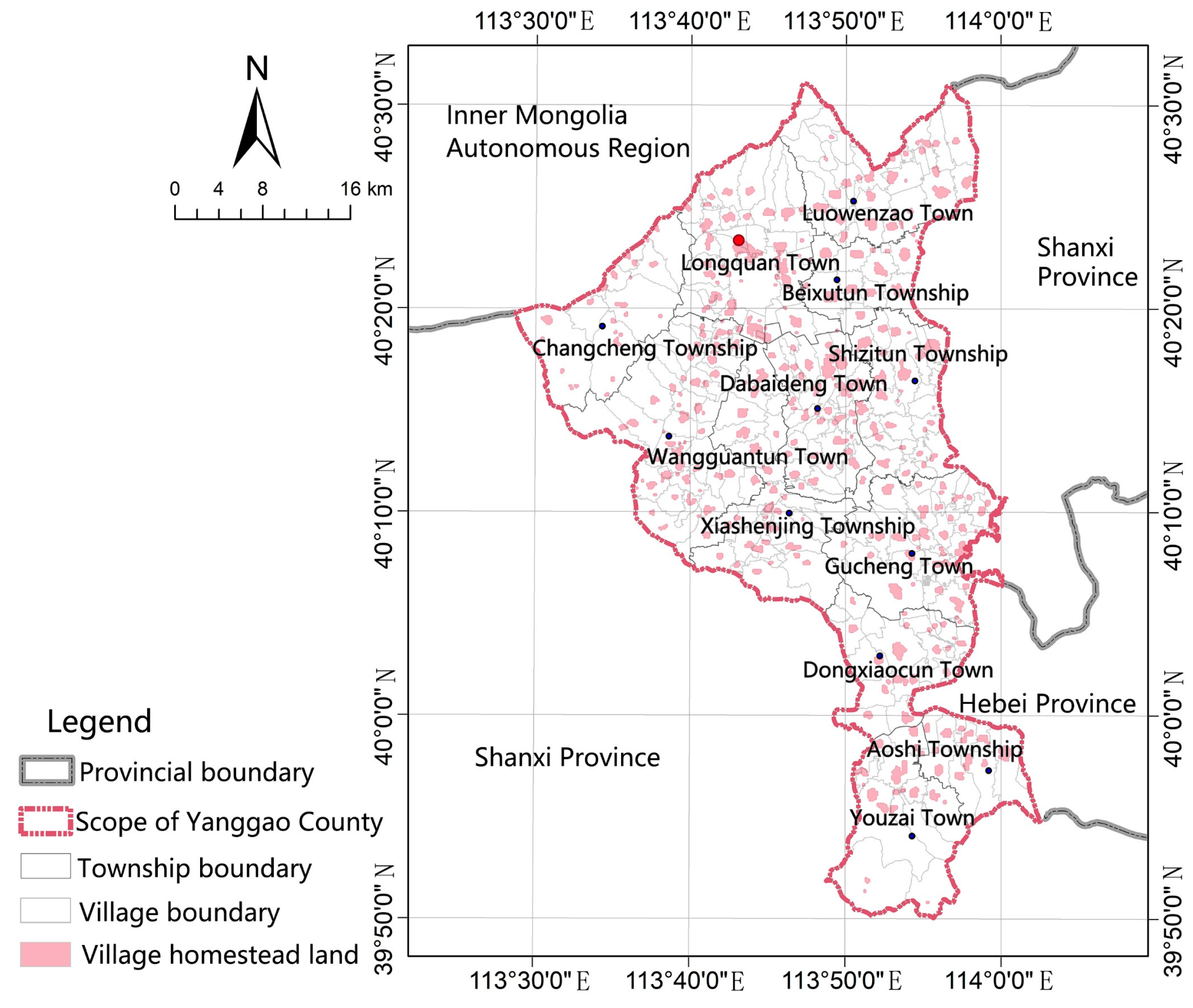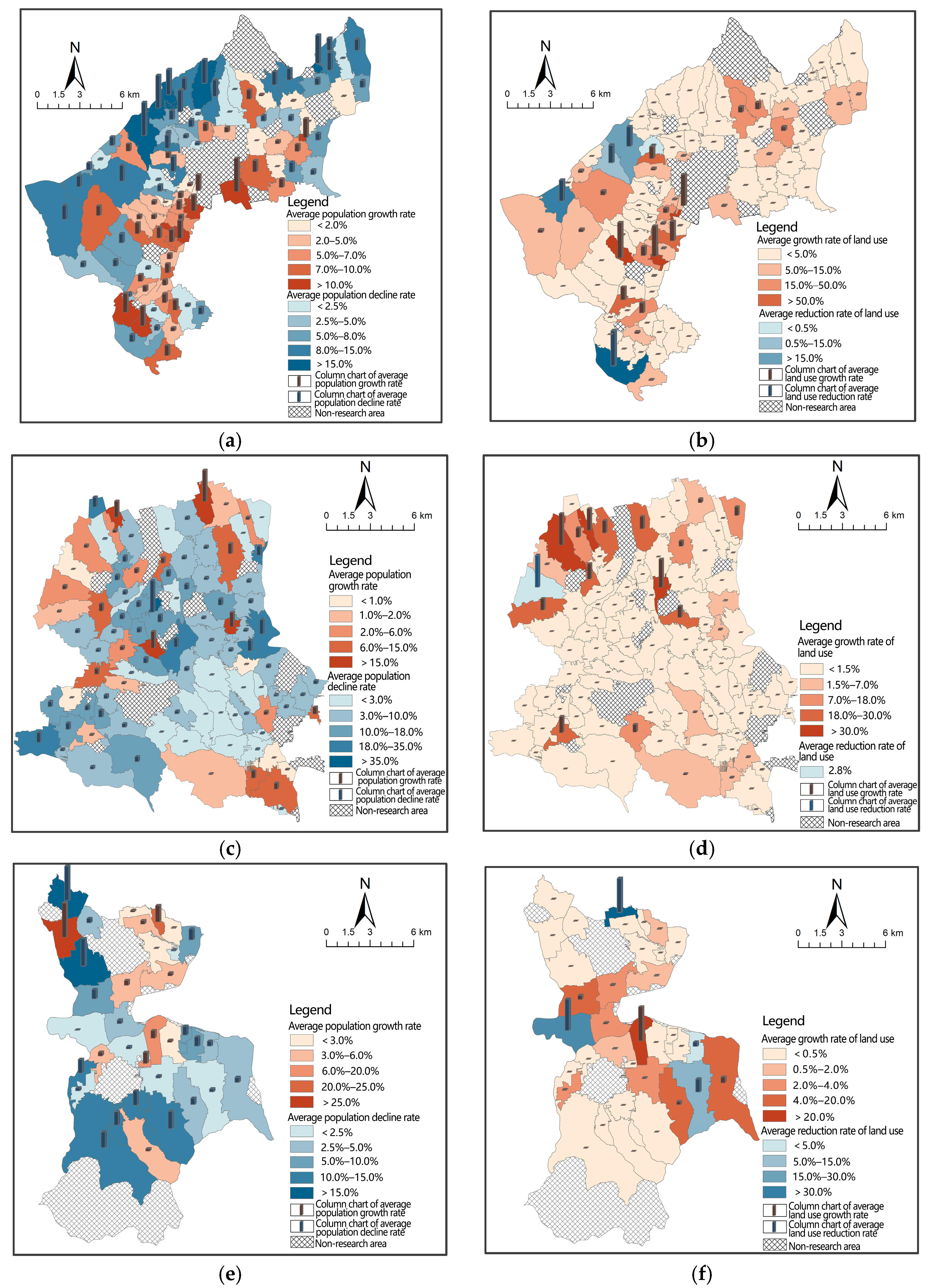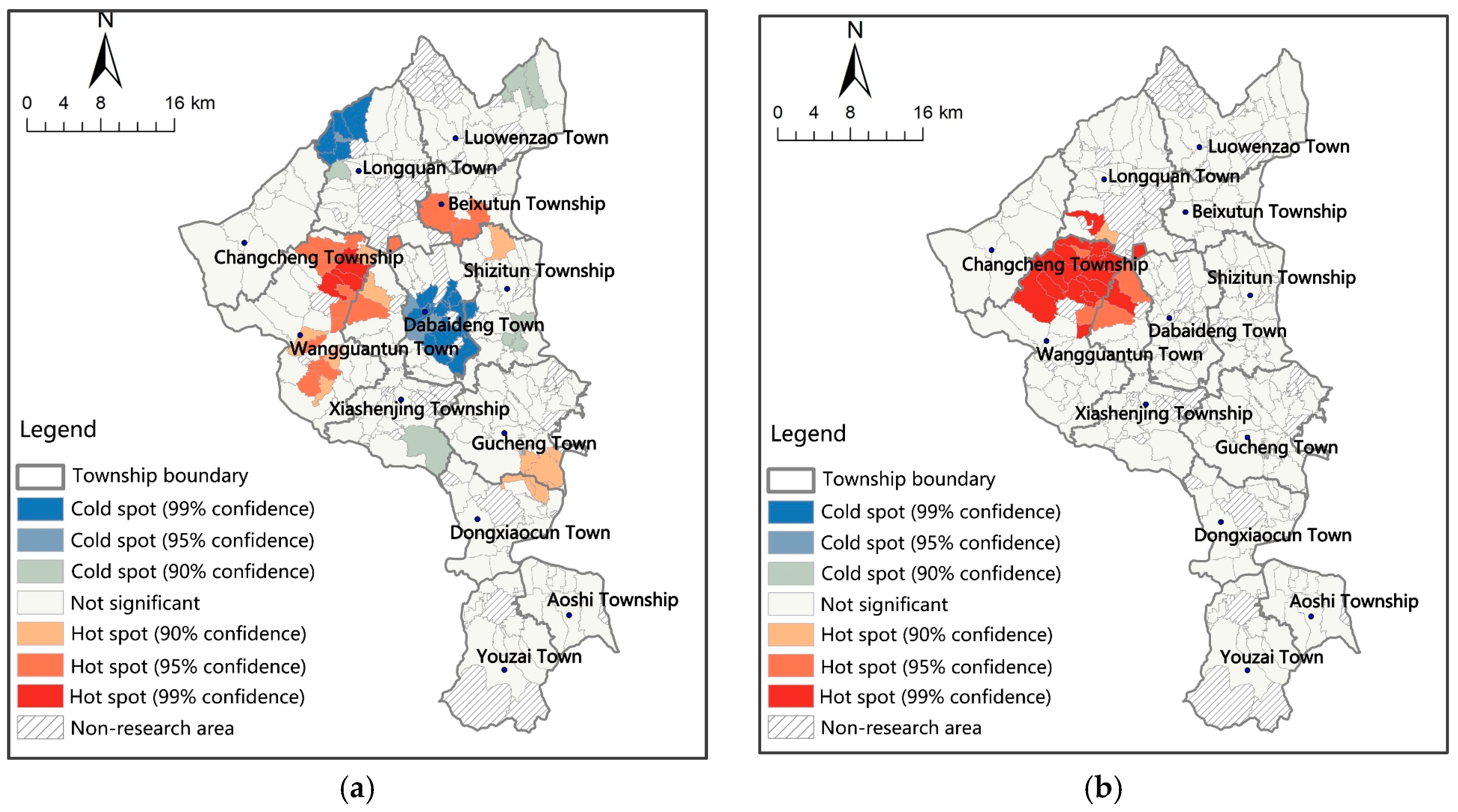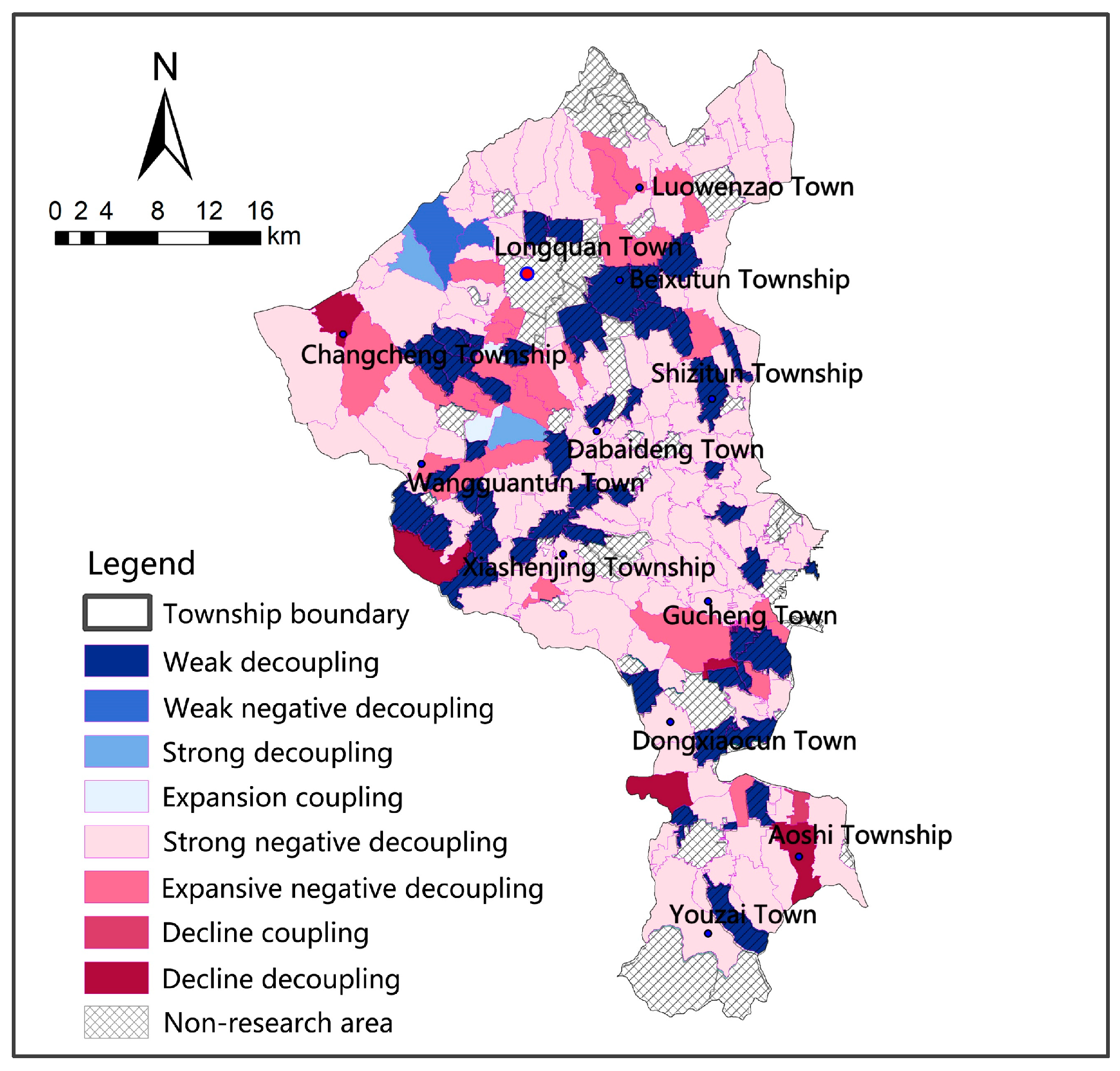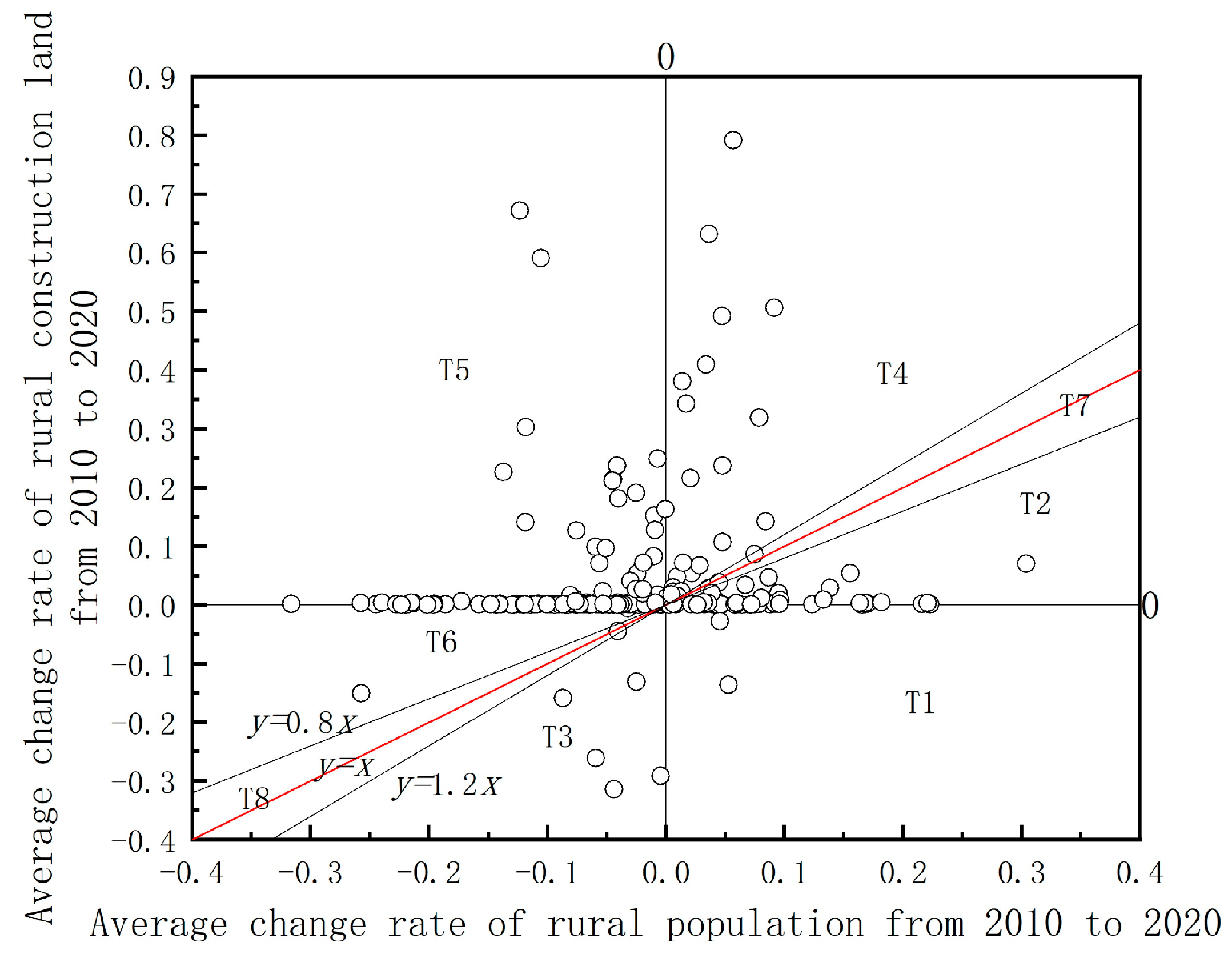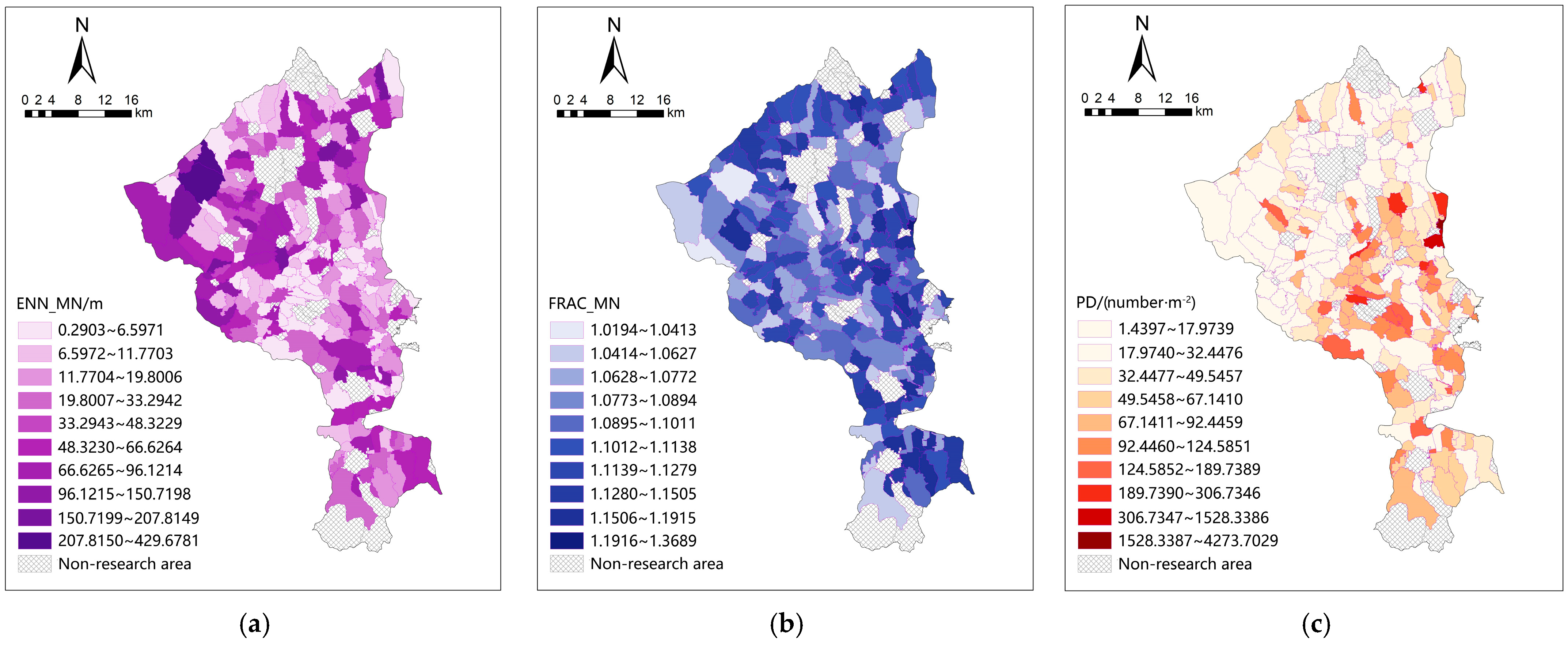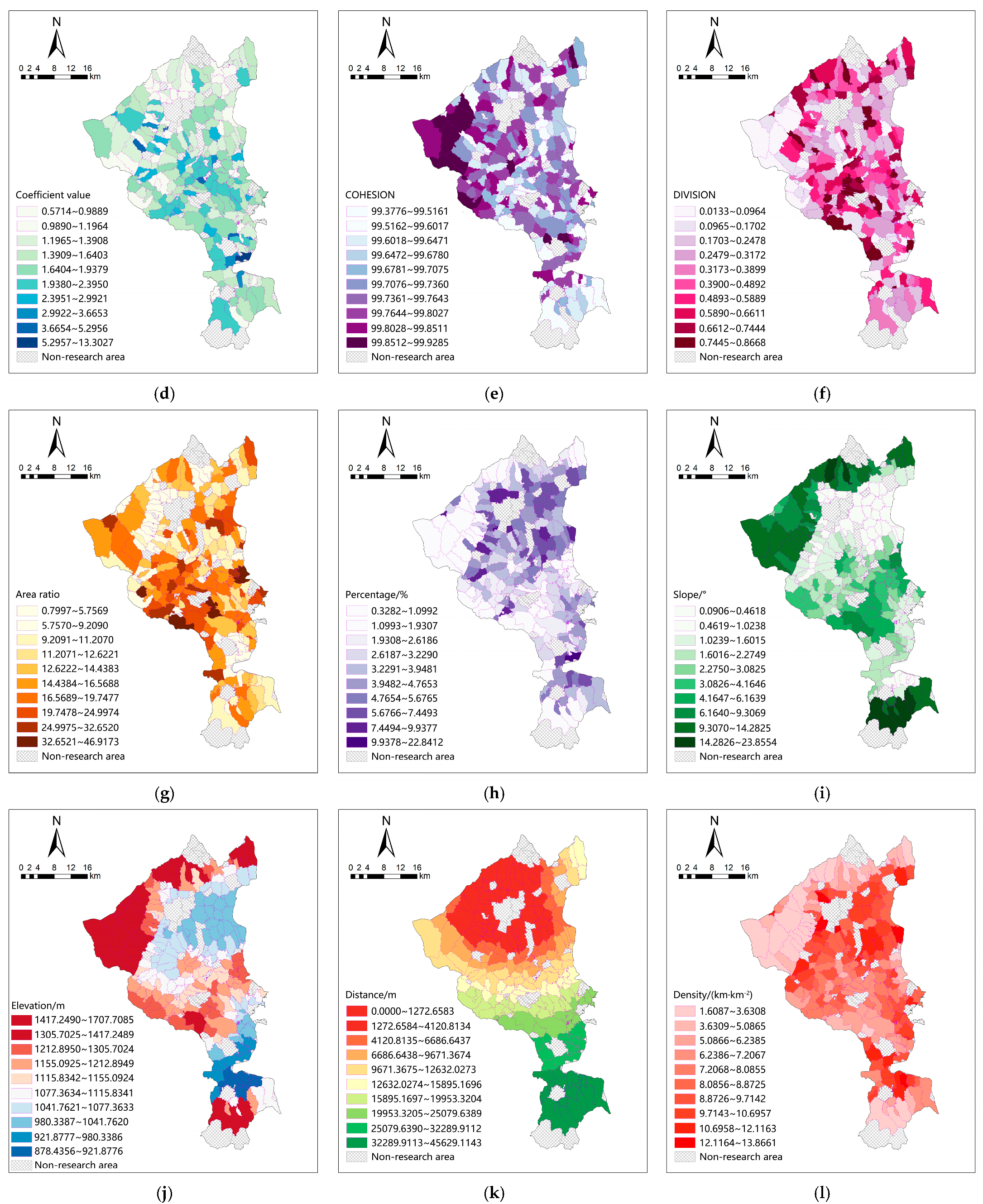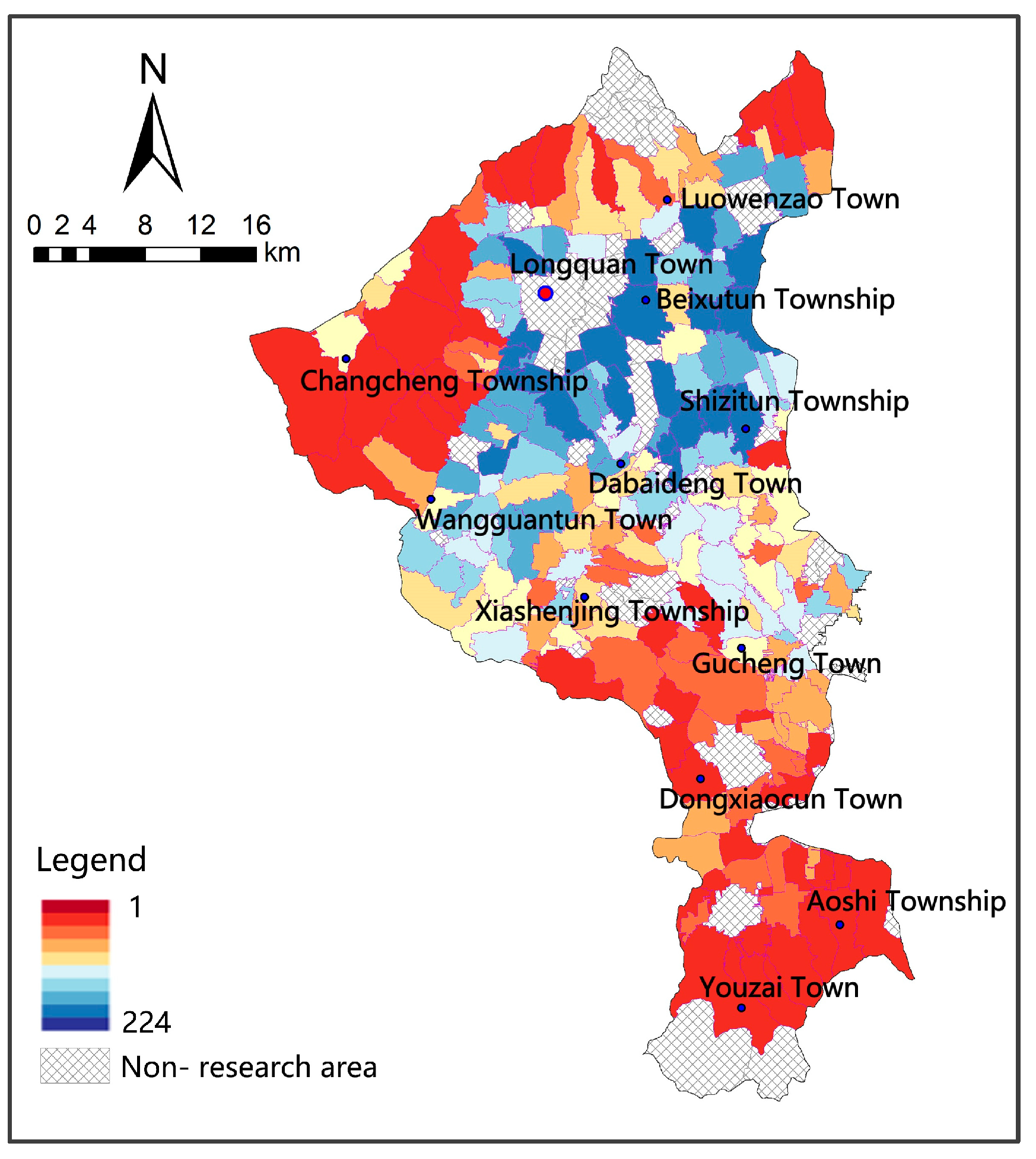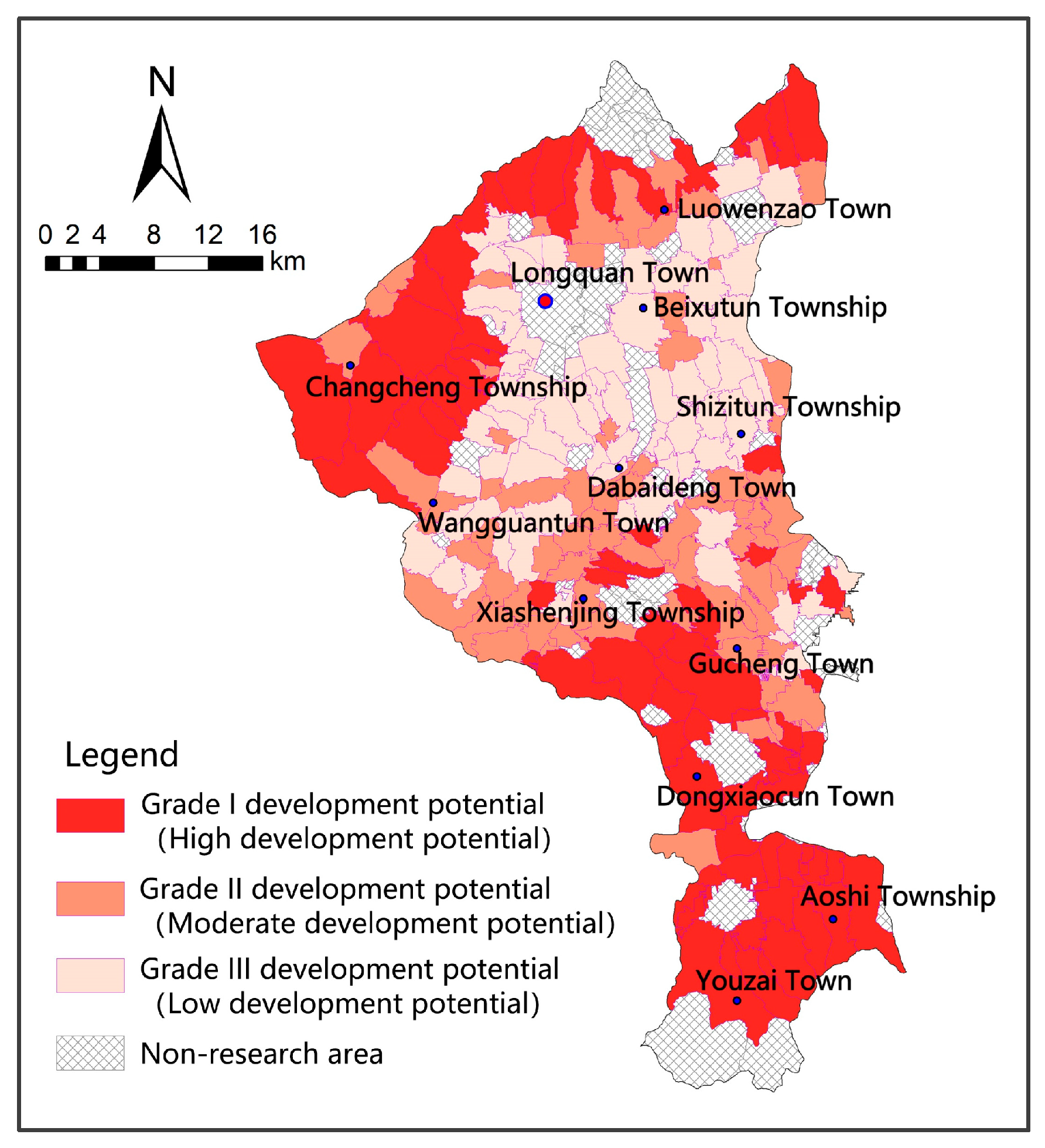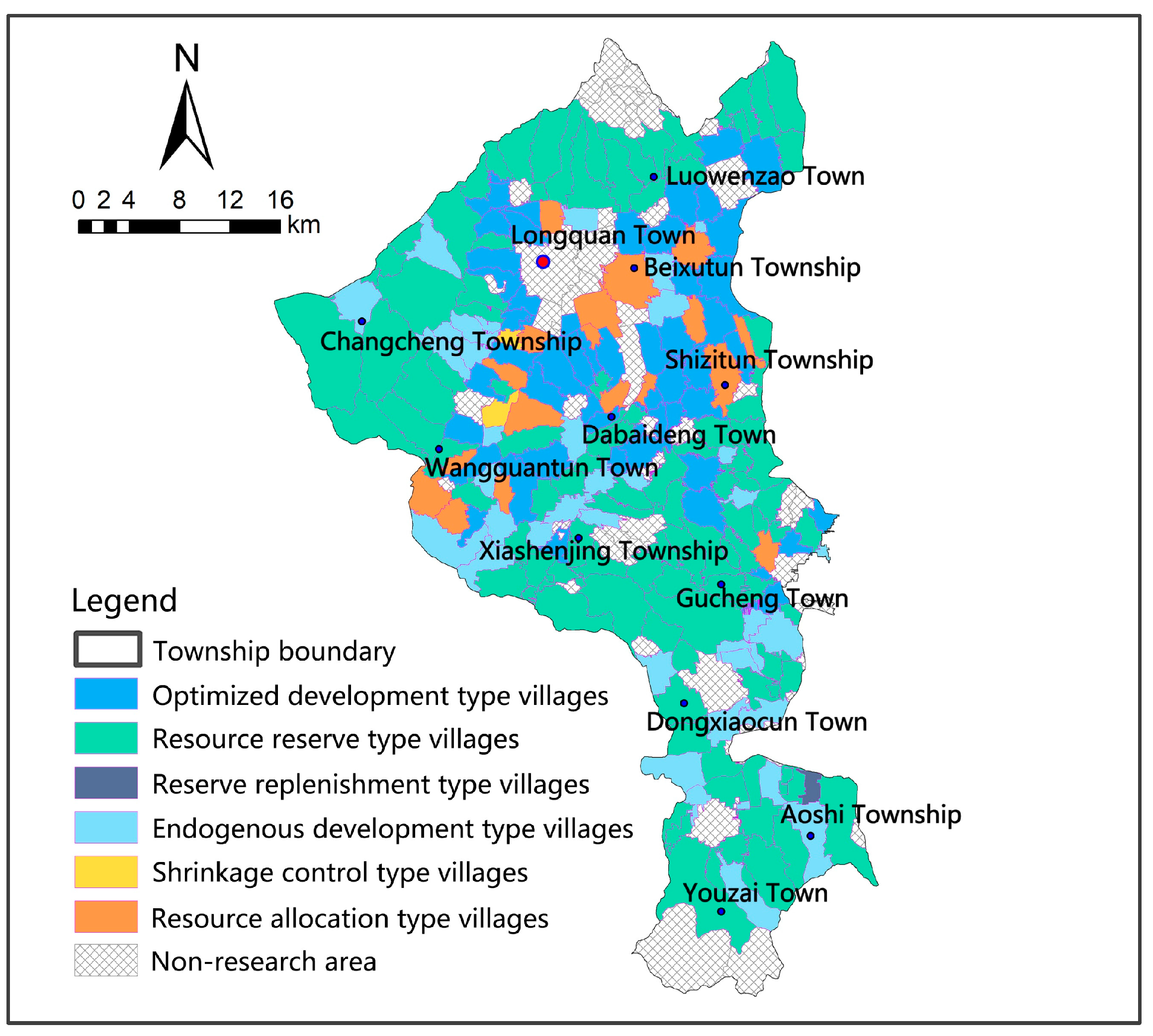1. Introduction
With the acceleration of global urbanization, rural population loss and land use changes have become widespread issues across the globe. The allocation of rural land resources faces significant challenges. The restructuring of rural population–land systems is driving innovation in land resource allocation mechanisms. In Japan, the aging and declining rural population are particularly severe, with 51% of Japan’s administrative regions experiencing substantial population loss and diminished vitality [
1]. This has led to the abandonment of farms and homes, with forests overtaking villages, posing a severe challenge to the harmonious relationship between humans and nature. In response to the demographic challenges faced by rural Japan, administrative mergers and tax reforms have already been implemented [
1,
2]. Additionally, in recent years, political debates surrounding economic decline, infrastructure issues, population decrease, and rural abandonment in Germany have resurfaced [
3].
Since China’s economic reforms and rapid development, there has been a significant demographic shift: between 1996 and 2016, the urban population increased by 433 million, while the rural population decreased by 275 million [
1]. However, despite this rural population decline, rural construction land did not decrease—in fact, it increased by 1.31% during the same period [
4]. This expansion of rural construction land has posed a threat to arable land and agricultural production [
5]. The phenomenon of rural hollowing out, coupled with the prevalence of multiple dwellings per household, has led to land abandonment and inefficient land use. The large-scale encroachment of construction land onto farmland has become widespread, reducing the availability of arable land and disrupting agricultural production. As a result, land resources are being wasted: newly developed construction areas often remain underutilized, while agricultural land, which could be more productively used, is taken away [
6,
7].
To address these challenges and prevent further rural decline, the Chinese central government proposed the Rural Revitalization Strategy (RRS) in 2017. The strategy aims to break long-standing bottlenecks in rural development and achieve comprehensive upgrades in agriculture, rural areas, and the overall development of farmers. Following this, the Strategic Plan for Rural Revitalization (2018–2022) was released in September 2018, outlining five major goals for rural revitalization: prosperous life, industrial prosperity, ecological livability, rural civilization, and effective governance [
8]. In line with these goals, the “Comprehensive Rural Revitalization Plan (2024–2027)” released in 2024 emphasizes deepening rural land system reforms, standardizing urban–rural land use balance, and prioritizing land for key rural industries.
Against this backdrop, the relationship between population and land in rural areas has become a central issue in the study of urban–rural resource allocation. Land, as a critical natural resource, serves not only as the foundation for economic activities but also as a key space for supporting ecological environments. Therefore, understanding the trends in the quantitative changes of rural population–land relationships, as well as the development potential of construction land, is essential for promoting regional socio-economic development and improving land resource allocation efficiency.
Rural areas serve as the fundamental foundation for rural socio-economic activities. The development of the economy and urbanization has led to a rapid outflow of rural populations, disrupting the originally harmonious relationship between rural populations and land. As a result, the population–land system in rural areas is undergoing significant restructuring and transformation [
9]. Research on the relationship between rural populations and land use changes primarily focuses on three areas. (1) The analysis of the decoupling of the rural population–land system. The decoupling model, originating from physics, indicates a lack of corresponding relationships between two or more physical quantities and is now widely applied in agriculture [
10,
11,
12], resources [
13,
14], and environmental [
15] studies. Li et al. (2019) applied a two-dimensional decoupling model in Hebei Province, finding that population growth and construction land expansion were largely uncoordinated, with 75.76% of counties showing weak decoupling. Their findings highlighted the need for targeted land-use zoning to optimize construction land efficiency and promote sustainable development [
16]. In the Yellow River Basin, Shi (2021) found a strong negative decoupling between rural population decline and the expansion of residential land from 2010 to 2016. They attributed this imbalance to intensive land utilization and urbanization, stressing the urgency of formulating sustainable rural development strategies to address the shrinking population and expanding residential land [
17]. In addition, Zhang et al. (2022) confirmed the negative decoupling trend in China, reinforcing the need for policies to better align land use with rural population trends to support ecological protection and rural revitalization [
18]. Together, these studies underscore the growing issue of uncoordinated land expansion and population decline in rural areas, urging integrated strategies to enhance land use efficiency and support sustainable rural development. (2) Dynamic changes in rural construction land. Existing research primarily focuses on the dynamic changes in land expansion and land transformation models, analyzing the driving mechanisms of land use changes. Zhu et al. (2020) explored the urban–rural construction land transition (URCLT) and its relationship with rural-to-urban population flow in the Yangtze River Delta, finding a shift from coupling to weak decoupling of land transitions and population flow between 2000 and 2015. The study emphasizes the need to regulate URCLT to ensure a stable urban–rural transition [
4]. Niu et al. (2022) examined the spatiotemporal characteristics of land-use transition in the Yangtze River Delta from 1990 to 2018, identifying key land transitions driven by government policies, industrial restructuring, and urbanization. They highlighted the increasing importance of urban–rural integration since 2010, with the transition from cultivated land to urban construction land being predominant [
19]. Yang et al. (2023) analyzed urban–rural land structural conflicts from 2000 to 2020, revealing an inverted U-shaped trend in urban–rural land expansion and emphasizing the decaying impact of socioeconomic factors on rural land expansion. Their study provides insights into achieving deep urban–rural land integration and promoting high-quality development [
20]. These studies illustrate the complex interactions between land transitions and population dynamics, underscoring the importance of policy-driven approaches to manage land use and urban–rural integration during ongoing transformations. (3) Rural land use quality and potential. The third area of research focuses on the evaluation of rural land use quality, including land intensification and development potential. Qu et al. (2021) identified various human–land interaction patterns, including the phenomenon of “Population Decline and Land Expansion (PDLE)” in Shandong Province, which posed challenges to intensive land use and eco-friendly development. They emphasized the need for policies that integrate human–land elements to promote sustainable rural development [
21]. Xu et al. (2011) highlighted the importance of assessing construction land potential in China to support urbanization and industrialization processes. Their spatial analysis identified unbalanced supply and demand for construction land, suggesting that regions with low land potential but high demand—such as Central and Eastern China—require targeted strategies to optimize land use [
22]. Yang et al. (2021) focused on homestead renovation as a crucial aspect of rural land consolidation. Their study demonstrated that homestead renovation potential is strongly influenced by local terrain conditions and spatial factors, suggesting that optimizing homestead use could significantly improve land use efficiency in rural areas [
23]. Together, these studies underscore the importance of evaluating land use quality and development potential through integrated models, spatial analysis, and policy interventions to address the inefficiencies and imbalances in rural land use. Additionally, research on changes in rural population–land relationships at different scales has drawn scholars’ attention to rural transformation and development, increasing studies on the transformation and interaction between rural population, land, and industries [
24,
25], thereby providing direction for rural transformation and revitalization.
Analysis indicates that existing research exhibits diverse perspectives and methodologies. However, the focus has primarily been on macro and meso-level analyses at national, regional, provincial, or municipal scales. There is a significant gap in micro-level quantitative research that examines changes in rural construction land and their driving mechanisms using villages as the basic unit of study. Moreover, studies that integrate the relationship between population–land changes and the potential for land consolidation are notably lacking [
26]. The study takes villages as the basic unit and, from the dual perspectives of rural population–land decoupling and construction land development potential, constructs a novel analytical framework and classification model. This model aims to identify villages with surplus construction land and reallocate their excess land to support development-oriented villages and county-level construction projects with land deficits. By deeply analyzing the driving mechanisms behind changes in rural construction land, the study ultimately provides a theoretical framework for optimizing land resource allocation. Specifically, the framework proposes methods for assessing land supply and demand across different regions, identifies factors influencing land use change, and suggests strategies for reallocating land in a way that balances the needs of rural development and agricultural sustainability. This approach helps to ensure a more efficient and equitable use of land resources, promoting sustainable rural development.
3. Results
3.1. Spatiotemporal Changes in Rural Population and Construction Land in Yanggao County from 2010 to 2020
At the county level, Yanggao County experienced a continuous decline in its rural population from 2010 to 2020. The rural population decreased from 239,300 in 2010 to 189,100 in 2020, representing a total reduction of 50,200 people, with an average annual decrease of 2.10%. The rate of population change varied over different periods. From 2010 to 2015, the population showed a slow decline. However, from 2015 to 2020, due to the introduction of China’s new type of urbanization concept, the rural population in Yanggao County experienced a rapid decline, with an average annual decrease of 4.7%. New-type urbanization is characterized by the coordinated development of urban and rural areas, urban–rural integration, interaction between industry and cities, resource conservation, ecological livability, and harmonious development. This concept plays a significant and positive role in promoting the high-quality development of urbanization in China.
During the same period, the area of rural construction land in Yanggao County consistently increased. The construction land area expanded from 4793.75 hectares in 2010 to 5245.05 hectares in 2020, marking a total increase of 451.30 hectares, with an average annual growth of 50.14 hectares, or 1.05%. Between 2010 and 2016, the growth in construction land area was relatively slow, with an average annual increase of 0.37%. However, from 2016 to 2020, the growth rate accelerated significantly, with an average annual increase of 2.34%, as shown in
Figure 2.
At the rural scale, the study divides Yanggao County into three regions: northern, central, and southern, as illustrated in
Figure 3. Overall, from 2010 to 2020, 140 (62.5%) villages experienced a population decline, while 214 (95.54%) villages saw an increase in construction land. In the northern region, which includes Longquan Town, Luowenzao Town, Changcheng Township, Beixutun Township, and Wangguantun Town, there was significant variability in village population changes. The number of villages with population decreases was roughly equal to those with population increases, with four villages showing a marked reduction in construction land. In contrast, Longquan Town experienced substantial growth in rural construction land. The northern towns exhibited pronounced spatial heterogeneity in population–land dynamics. In the central region, which encompasses Xiashenjing Township, Dabaideng Town, Shizitun Township, and Gucheng Town, most villages faced population declines, but construction land generally increased. The closer a village was to Longquan Town, the county seat, the greater the increase in construction land. In the southern region, which includes Youzai Town, Aoshi Township, and Dongxiaocun Town, three villages experienced significant reductions in construction land. The southern part of Yanggao County exhibited a general trend of gradual population decline and minimal increases in construction land. Overall, from 2010 to 2020, Yanggao County’s rural population consistently decreased while construction land was inefficiently used, characterized by extensive land utilization.
From the spatial analysis of hotspots and coldspots in rural population–land changes in Yanggao County (
Figure 4), it is evident that these changes exhibit a typical pattern of high-value and low-value clustering, with noticeable local spatial aggregation effects. For villages excluding town center villages and non-agricultural communities, population change hotspots are primarily located around Longquan Town, in Wangguantun Town, Beixutun Township, and the southern part of Gucheng Town. In these areas, rural populations have increased rather than decreased, indicating a counter-urbanization phenomenon typical in the mid-to-late stages of urban development.
Coldspot areas are concentrated in Dabaideng Town, which is undergoing rapid urbanization, resulting in significant rural population loss. Corresponding to the population change hotspots, the hotspots for changes in rural construction land are also concentrated around Longquan Town, particularly in Wangguantun Town, forming a certain degree of spatial clustering. There are no significant coldspot areas for construction land change, aligning with the overall trend of expansion in rural construction land area in Yanggao County, with only a few areas experiencing reductions.
The evolving patterns of rural population–land relationships in Yanggao County highlight the imbalanced development across different regions during the process of new urbanization. This imbalance is characterized by urban expansion near the city, stagnation in the suburban areas, and degradation at the periphery. Longquan Town in the north, serving as the county seat and regional economic core, attracts rural populations through employment opportunities and public services, leading to unidirectional migration [
44]. However, the traditional, one-size-fits-all approach to land management leads to the continued expansion of construction land in areas experiencing population decline. This approach is driven by outdated planning models that fail to account for the current dynamics of population movement, causing a mismatch between land allocation and actual demand. For instance, Luowenzao Town sees an average annual rural population decrease of 2.54%, while rural construction land increases by 3.01% annually, resulting in a “population decline, land expansion” phenomenon [
45]. Villages closer to the county seat experience stronger influence from the central town, with construction land expansion driven by infrastructure investments (an annual growth of 0.8%). In contrast, remote villages face ecological constraints, such as limited arable land due to steep terrain, fragile ecosystems prone to erosion, and environmental protection regulations that restrict land development. These factors, combined with a lack of economic vitality, lead to a gradual decline in rural populations and more restrictive land-use policies. This creates a “center-periphery” contraction gradient, where areas closer to the county seat thrive, while more remote areas experience stagnation or decline. The dynamics within Yanggao County’s rural population–land system result from the interplay of three key forces: the push effect of urban siphoning, the pull effect of land inertia, and the resistance due to uniform institutional frameworks [
46]. The “push effect of urban siphoning” refers to the migration of rural populations toward urban centers, driven by the availability of better employment opportunities, infrastructure, and public services. This movement is encouraged by the increasing centralization of economic activities and the growth of urban areas. The “pull effect of land inertia” is the tendency for rural areas to continue expanding construction land even when population growth has slowed or reversed. This is a result of outdated land management practices that do not account for shifting demographic patterns, leading to unnecessary land allocation in areas where demand for land has diminished. Finally, “resistance due to uniform institutional frameworks” refers to the rigid, one-size-fits-all institutional policies that govern land use across both urban and rural areas. These policies often fail to adapt to the specific needs of different regions, restricting more flexible and targeted land management approaches that could better address local conditions.
3.2. Rural Population–Land Decoupling Results
To accurately understand the rural population–land relationship, this study calculates the decoupling coefficients and examines the population–land dynamics of 224 villages in Yanggao County. The results, as shown in
Table 5, indicate that from 2010 to 2020, the decoupling relationship between rural construction land and rural population in Yanggao County exhibited various types. These include strong decoupling, weak decoupling, decline decoupling, expansive negative decoupling, strong negative decoupling, weak negative decoupling, expansion coupling, and decline coupling. These eight modes reflect the complex and dynamic relationship between rural population and construction land.
Overall, the decoupling coefficient between rural population and construction land in Yanggao County is −2.82, indicating a strong negative decoupling. This suggests that the rural resident population is decreasing at a higher rate than the expansion of construction land, reflecting a significant “population–land separation” phenomenon. The allocation mechanism, which is based on registered household population, is disconnected from the dynamic reality of population migration. This disjunction results in the inability to reclaim idle homesteads and the continued allocation of new construction land, thereby causing a spatial lock-in effect. In other words, the existing land allocation system fails to adapt to the changing population distribution, leading to the inefficient use of land. Moreover, this trend is exacerbated by the reliance on land finance and the lagging management system of homestead land. As a result, areas with declining populations are unable to repurpose or reallocate unused land, while new land continues to be allocated in areas with less demand, reinforcing patterns of underutilized land and limiting spatial flexibility.
At the village level, as shown in
Figure 5 and
Figure 6, only two villages exhibit strong decoupling, where population growth is accompanied by a reduction in construction land. Five villages show decline decoupling, characterized by simultaneous decreases in both population and construction land, with construction land decreasing more rapidly. Two villages fall into the weak negative decoupling category, where both population and construction land decrease, but the population decreases faster. Another two villages display expansion coupling, where both population and construction land increase in tandem. Finally, one village demonstrates decline coupling, with concurrent decreases in both population and construction land. Collectively, these five types account for only 5.36% of the total number of villages.
Among the remaining 212 villages, 49 (21.88%) villages fall into the weak decoupling category, where both population and construction land increase, but population growth outpaces land expansion. Expansive negative decoupling accounts for 28 (12.50%) villages, characterized by simultaneous increases in population and construction land, with land expansion occurring more rapidly. These two types of villages are predominantly located within the county seat’s radiating area (Longquan Town). Their land expansion is driven by short-term population return or infrastructure investments. However, the inadequate provision of public services, such as healthcare, education, public transportation, and utilities, undermines the sustainability of this growth pattern. The majority of villages, 135 (60.27%) villages, exhibit strong negative decoupling, where there is a significant population decline alongside a continuous expansion of construction land. This trend is detrimental to the concentrated development of rural construction land. An in-depth analysis reveals that this phenomenon is driven by several key mechanisms. Firstly, the dependence on land finance motivates local governments to prioritize land sales for revenue, leading to continuous construction land expansion despite population decline. Secondly, the lagging management system of homestead land results in inefficient reclamation and repurposing of idle homesteads. Additionally, the lack of effective land-use planning and regulation exacerbates the issue, as current policies may not adequately address the mismatch between land allocation and demographic changes. Lastly, the inadequate infrastructure and services in rural areas can discourage population retention and attract investment, further contributing to the imbalance between population and construction land use. Addressing these root causes through comprehensive land finance reform, improved homestead land management, enhanced land-use planning, and investment in rural infrastructure is crucial for fostering sustainable rural development.
3.3. Evaluation Results of Rural Construction Land Development Potential
Initially, the indicator values for each unit are calculated using the formulas from
Table 2, and these values are visualized by categorizing them into 10 levels using the natural break classification method, as illustrated in
Figure 7.
Subsequently, the improved TOPSIS method is employed to rank and visualize the potential for rural construction land consolidation within the study units (
Figure 8). The natural breakpoint method is used to divide the development potential of rural construction land in Yanggao County into three categories (
Figure 9). The results reveal a spatial pattern of consolidation potential in Yanggao County, characterized by higher potential in the north and south, lower potential in the center, higher potential in mountainous and hilly areas, and lower potential in plains and urban centers. The villages in the mountainous regions of the northwest and southeast exhibit the highest consolidation potential, categorizing them as top-priority areas. In these regions, construction land is primarily distributed intermittently along roads, with many plots scattered within forested valleys. The harsh living conditions and high living costs in these areas make them key targets for homestead reclamation. The central part of Yanggao County also shows significant potential, placing these villages in the second priority tier. This area is influenced by a relatively dense population and convenient transportation, which leads to common spatial displacement of construction land and a higher likelihood of old village abandonment. Villages near the county center have lower potential, categorizing them in the third priority tier. The proximity to the urban center results in more mature land-planning and development models. Under the dual influence of government oversight and market regulation, rural land use in these areas tends to be more orderly, but higher reclamation costs limit the potential for construction land consolidation.
3.4. Linkage Models Between Rural Population–Land Decoupling and Construction Land Development Potential
The analysis of the linkage models between rural population–land decoupling and construction land development potential in Yanggao County reveals six distinct rural development types, as shown in
Figure 10. The specific results are as follows:
Resource allocation villages: These account for 8.04% (18 villages) and are primarily located around the county seat and surrounding towns. These villages benefit from their peri-urban location, absorbing spillover industries from the county seat, leading to a shortage of construction land indicators and necessitating the import of indicators.
Endogenous development villages: Comprising 16.96% (38 villages), these villages leverage the upgrading of local agricultural industries to achieve growth through the intensive use of land.
Resource reserve villages: The largest group, making up 49.11% (110 villages), these villages are primarily distributed in the northern and southern mountainous areas, as well as in the central and southern townships, which are farther from the county center. These villages face a stark contrast between high development potential and inefficient land use, highlighting the challenge of decoupling in the population–land system. Due to continuous population loss and a monotonous industrial structure, the actual development of these villages is delayed, manifesting a phenomenon of “potential inactivity”. These villages need to activate their reserved land resources through the county-level indicator trading platform to support future regional development.
Optimized development villages: This category accounts for 24.55% (55 villages) and is mainly located in the townships surrounding the county center. Although these villages exhibit lower potential for construction land consolidation, their advantageous location, well-developed transportation infrastructure, and favorable policies contribute to vibrant economic growth and relatively low population loss. Enhancing land efficiency in these areas requires strategies such as “vertical development”, which refers to increasing the use of land by building upwards (e.g., constructing multi-story buildings instead of spreading horizontally), and “functional replacement”, which involves transforming existing land uses to more efficient or appropriate uses based on the area’s development needs (e.g., converting underutilized idle land into industrial or commercial land) [
47]. These strategies help maximize land use while respecting ecological and topographical constraints.
Reserve replenishment villages: Yanggao County has only one village of this type. This village exhibits a high potential for construction land consolidation and features a strong human–land coupling development.
Shrinkage control villages: Only two villages belong to this development type. A shrinkage control strategy is necessary [
48], focusing on resource integration, service optimization, and infrastructure enhancement to ensure basic living and development conditions. Specifically, “resource integration” refers to effectively combining and utilizing available resources, such as consolidating agricultural land or repurposing unused buildings for new community purposes. “Service optimization” involves improving essential services like healthcare, education, and social welfare to meet the needs of the remaining population, such as offering mobile health clinics or remote education programs. “Infrastructure enhancement” includes upgrading physical infrastructure such as roads, utilities (e.g., water and electricity), and public transportation to improve accessibility and quality of life. These measures are aimed at making these villages more livable and sustainable, even in the face of shrinking populations.
3.5. Results of the Driving Mechanisms of Rural Construction Land Changes
Based on migration patterns, the 224 villages were divided into two groups: 53 villages with net population inflow and 171 villages with net population outflow. For villages with a net increase in construction land area, the key influencing factor was determined by selecting the maximum value among four calculated factors. Conversely, for villages with a net decrease in construction land area, the minimum value among the four factors was chosen as the key influencing factor. The quantitative statistics of these key factors influencing changes in rural construction land are presented in
Appendix A and
Table A1 and
Table A2.
In villages with net population inflow, 35% of those with an increase in construction land area are influenced by the rising proportion of permanent residents, while 32% are affected by overall population growth. These villages are widely distributed, primarily located in the northern and central towns of Yanggao County. Conversely, the proportion of villages with net population inflow experiencing a decrease in construction land area is smaller. Among these, 38% are influenced by land-use efficiency. These villages are fewer in number and mainly situated in the southern part of Yanggao County.
For villages with net population outflow and an increase in construction land area, land-use efficiency and the increasing proportion of outflow population are key influencing factors, affecting 36% and 30% of these villages, respectively. These villages are relatively scattered, primarily concentrated in Gucheng Town and Wangguantun Town, reflecting a lack of rigidity in land-planning policies leading to reverse regulation [
49]. In villages with net population outflow and reduced construction land area, the decrease in land use efficiency, the decrease in the proportion of permanent residents, and the decrease in total population have had negative impacts on 33%, 28%, and 28% of villages, respectively. These villages are mainly located in the southern part of Yanggao County. With the vigorous implementation of rural homestead reclamation (which involves converting unused or abandoned homestead land back into productive agricultural land or repurposing it for new development) and relatively stable net population loss ratios, land-use efficiency has significantly improved. By reclaiming idle homesteads and consolidating land use, the remaining construction land is used more efficiently, allowing for better management of land resources even with a declining population. This process not only helps to optimize land utilization but also prevents the further expansion of construction land, ensuring more sustainable land management.
4. Discussion
4.1. Strategies for Adjustment and Optimization of Rural Land Resources
4.1.1. Experience and Enlightenment of International Governance in Rural Land Optimization
Global governance experiences offer valuable insights for optimizing rural land resources [
50]. In regions like Germany, rural governance is shaped by progressive ruralism, which emphasizes the importance of stable public funding and democratized municipal decision-making for ensuring social and spatial justice [
3]. This approach supports flexible, community-driven land-use planning, with an emphasis on local participation and sustainable development. Similarly, in southern Germany, land management decisions are often influenced by a lack of comprehensive quantitative data, highlighting the need for more informed decision-making frameworks that balance economic, social, and environmental factors [
51].
The UK’s rural governance, especially in the post-Brexit context, stresses the integration of sectors beyond agriculture, including infrastructure, social relations, and environmental sustainability. It underscores the necessity of a holistic approach to rural development, where land-use decisions must consider the broader implications for rural communities and the environment [
52]. This is particularly relevant for China, which, despite its hierarchical governance structure, has adopted a hybrid approach combining centralized control with quasi-autonomous local governance. For example, Tianjin’s rural redevelopment efforts highlight the complexities of land rights redistribution and the importance of balancing economic growth with social and ecological considerations [
53].
These international governance models—spanning Germany’s progressive ruralism, the UK’s comprehensive rural development, and China’s hybrid governance—provide valuable lessons for tailoring land optimization strategies to local contexts. By integrating flexible, participatory approaches with comprehensive data analysis and sustainable land-use practices [
8], rural land governance can be more responsive to both development needs and environmental constraints.
4.1.2. Village Classification Governance Strategy
For the study area, which has been categorized into resource allocation, endogenous development, resource reserve, optimized development, and contraction control regions, the paper proposes corresponding optimization pathways [
38,
54,
55].
Develop a “flexible land supply and targeted allocation” mechanism. Dynamically match land-use quotas based on population inflow trends, prioritizing infrastructure and industrial land in northern population concentration areas [
56]. Establish a dynamic “population–land growth linkage” model, requiring the receiving area to provide industrial implementation commitments. Automatically trigger incremental quota allocation when the growth rate of the permanent population exceeds a specified threshold, thus preventing supply–demand imbalances caused by planning delays.
- 2.
Endogenous Development Type:
Implement a “stock activation and functional replacement” strategy. For secondary potential villages, enhance land-use efficiency through methods such as converting idle homesteads—typically vacant or underused residential properties—into collectively operated construction land. This conversion can be achieved by repurposing these homesteads for shared community purposes, such as constructing public service facilities (e.g., community centers, markets, or local health clinics) or developing small-scale commercial spaces. These projects would be managed collectively by the village or a designated cooperative, ensuring that the land is used efficiently for the benefit of the community [
57]. Villages with the highest land development potential focus on a “micro-renewal” model, utilizing data from the third national land survey to identify inefficient land use. By promoting functional integration and increasing floor area ratios, these villages aim to enhance spatial value [
4].
- 3.
Resource Reserve Type:
Implement a “quota trading and cross-regional transfer” model. Establish a county-level construction land quota reserve, allowing high-potential villages (with grade I development potential) to transfer land quotas across regions through land transactions, with proceeds specifically directed towards the construction of village-level public service facilities. These facilities include essential infrastructure and services such as schools, healthcare centers, community halls, recreational areas, and local markets that cater to the daily needs of the village population. For secondary potential villages, implement a “quota pre-allocation + balance of land occupation and compensation” mechanism, prioritizing the land needs for modern agricultural facilities. This mechanism involves the advance allocation of construction land quotas specifically for agricultural infrastructure development, ensuring timely land supply for projects such as smart greenhouses, cold-chain logistics centers, and agricultural product processing workshops. At the same time, it adheres to the principle of the “balance of land occupation and compensation”, meaning that any newly occupied construction land must be offset by reclaiming or restoring equivalent areas of cultivated land elsewhere in the village. For example, if 5 hectares of land are used for building a modern farming park, an equivalent area of low-efficiency land can be rehabilitated into high-quality farmland to maintain overall land balance. This model offers a pragmatic development path tailored to secondary potential villages, distinct from the cross-regional quota trading model suited for villages with the highest development potential.
- 4.
Optimized Development Type:
Strengthen the “population–land linkage + precise revitalization” approach. Villages under this model exhibit slow population growth but a rapid expansion of construction land, with limited development potential. It is essential to determine the upper limit of construction land based on the resident population, imposing a low-efficiency utilization tax on areas that exceed this limit. It is recommended to establish a “blacklist of idle land” system, mandating the withdrawal of plots that have remained undeveloped for three consecutive years. Priority should be given to repurposing these lands for the construction of new energy facilities, such as solar or wind energy plants, or ecological corridors—green areas designed to connect habitats and support biodiversity. These corridors help mitigate urban sprawl, protect ecosystems, and enhance environmental sustainability.
- 5.
Shrinkage Control Type:
In this model, the trends of rural construction land and permanent population growth or decline are synchronized, and the development potential is relatively low. These villages should implement a “reduction planning and ecological anchoring” rigid control strategy [
58]. Ecological anchoring refers to the establishment of protected areas within the village or surrounding regions, focusing on the conservation of critical ecological zones, such as wetlands, forests, or biodiversity corridors, which help to maintain the ecological balance and prevent environmental degradation. These areas also can act as natural buffers against urban expansion. These villages should establish a strict construction land reduction boundary, prohibiting new non-agricultural projects. Policies such as homestead exit compensation, the balance of arable land occupation and compensation, and revenue incentives should be employed to facilitate the orderly reclamation of land in depopulated southern areas [
59], with the reallocated quotas primarily supporting development in the northern regions.
- 6.
Reserve Replenishment Type:
To address the characteristics of population–land synchronous fluctuations, a “dynamic quota pool” mechanism should be established. The dynamic quota pool refers to a flexible system that adjusts land quotas based on changes in population dynamics. During periods of population growth, the reserved land should be released, with priority given to the development of public service facilities, such as health stations and logistics hubs, to improve the village’s capacity to support its population. For example, if a village experiences a significant population increase, the dynamic quota pool can release additional land for the construction of essential services to accommodate the growing demand. During contraction periods, idle or underutilized land should be converted into ecological land credits, which are then deposited into the county-level trading platform for potential future use.
4.1.3. Implications of the Policy Implementation Strategy
The proposed governance strategies for village classification emphasize a phased implementation pathway to enhance operability and effectiveness. By segmenting the policy into short-term pilot projects, mid-term promotion phases, and long-term optimization strategies, the approach ensures systematic and adaptable progress.
Short-term (Pilot Phase): Initiate pilot projects to test the feasibility of proposed mechanisms in selected areas. For instance, in resource allocation-type villages, a “flexible land supply and targeted allocation” mechanism can be piloted in regions experiencing population growth. This phase aims to gather practical insights, identify potential challenges, and refine the strategies based on real-world outcomes.
Mid-term (Promotion Phase): After the pilot phase, successful strategies should be promoted and scaled up across broader regions. This includes implementing dynamic “population–land growth linkage” models and extending quota trading systems to facilitate balanced development. The promotion phase focuses on adapting and standardizing the approaches based on the pilot results, ensuring they are effective and sustainable.
Long-term (Optimization Phase): In the long term, continuous monitoring and refinement of the strategies are essential. This phase involves optimizing the land supply mechanisms, enhancing the efficiency of resource use, and ensuring environmental sustainability. For instance, developing an elastic coefficient warning system to adjust land quotas dynamically based on population changes will help maintain a balanced and efficient land-use strategy.
By structuring the policy implementation in these phased pathways, the recommendations become more actionable and adaptive, addressing both immediate needs and long-term goals.
4.2. Limitations of the Study
A significant issue with the current methodology for evaluating rural construction land potential is the failure to differentiate between various village functions, such as agricultural, industrial, tourism, ecological protection, traditional settlements, and other possible classifications. This oversight can lead to inaccurate assessments, either overestimating or underestimating the actual potential of specific villages.
Each village type has distinct land-use requirements and development trajectories. Agricultural villages primarily need land for farming and related infrastructure, while industrial villages require extensive areas for factories and production facilities. Tourism villages demand land for attractions, accommodations, and services catering to visitors. Ecological protection villages focus on preserving natural resources and may need land set aside for conservation efforts. Traditional villages, with their historical and cultural significance, have unique preservation and land-use requirements.
The analysis reveals that applying a uniform per capita construction land indicator across these diverse village types often leads to misrepresentations. For instance, in Yanggao County, industrial villages in the north show a substantial need for industrial land, which is not adequately captured by the standard per capita measure, resulting in an underestimation of their potential. Conversely, tourism villages may have potential for growth in visitor services that is not reflected when using a generalized assessment model, leading to an underutilization of their unique potential. Similarly, ecological protection villages might appear to have underutilized land when, in fact, their low development intensity is intentional and necessary for conservation.
To address these discrepancies, it is crucial to refine potential assessment models by incorporating specific functional classifications of villages. This approach should involve developing tailored indicators for each village type and dynamically adjusting these indicators based on evolving village functions.
Moreover, the mechanism for the withdrawal of rural construction land is the result of comprehensive negotiations among multiple stakeholders. It is influenced not only by external objective factors but also by the willingness of farmers to participate in land consolidation and the execution capacity of the government. Therefore, future efforts should incorporate various rural governance tools to promote the sustainable development of land resources through the coordinated allocation of rural land.
4.3. Research Application Potential and Issues Addressed
This study not only offers new perspectives for understanding the driving mechanisms behind land-use changes but also provides a crucial theoretical and methodological foundation for rural land regulation. By focusing on the supply and balance of rural land quotas, it offers a robust basis for assessment and quota calculation. Unlike studies that use provincial, municipal, or county administrative divisions as units of analysis [
60,
61], this research employs villages as the basic units. This approach more precisely reveals micro-level changes in rural land use and population mobility, delivering more detailed data to deepen our understanding of the population–land relationship.
Furthermore, the article identifies six types of linkage models and proposes targeted deconstruction pathways to adjust land-use and management practices based on specific local conditions. By breaking away from traditional governance logic—such as one-size-fits-all land policies or top-down decision-making—this approach encourages more flexible and tailored strategies for land management. This offers an operational paradigm for the precise adaptation of the “differentiated land supply” provisions outlined in China’s Regulations on the Implementation of the Land Administration Law. Although the study uses Yanggao County, a northern Chinese county, as a case example, the methodology and analytical framework are highly generalizable due to their simplicity and the relatively easy access to data.
